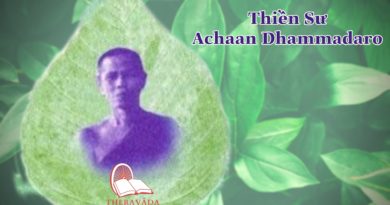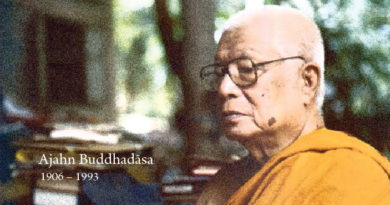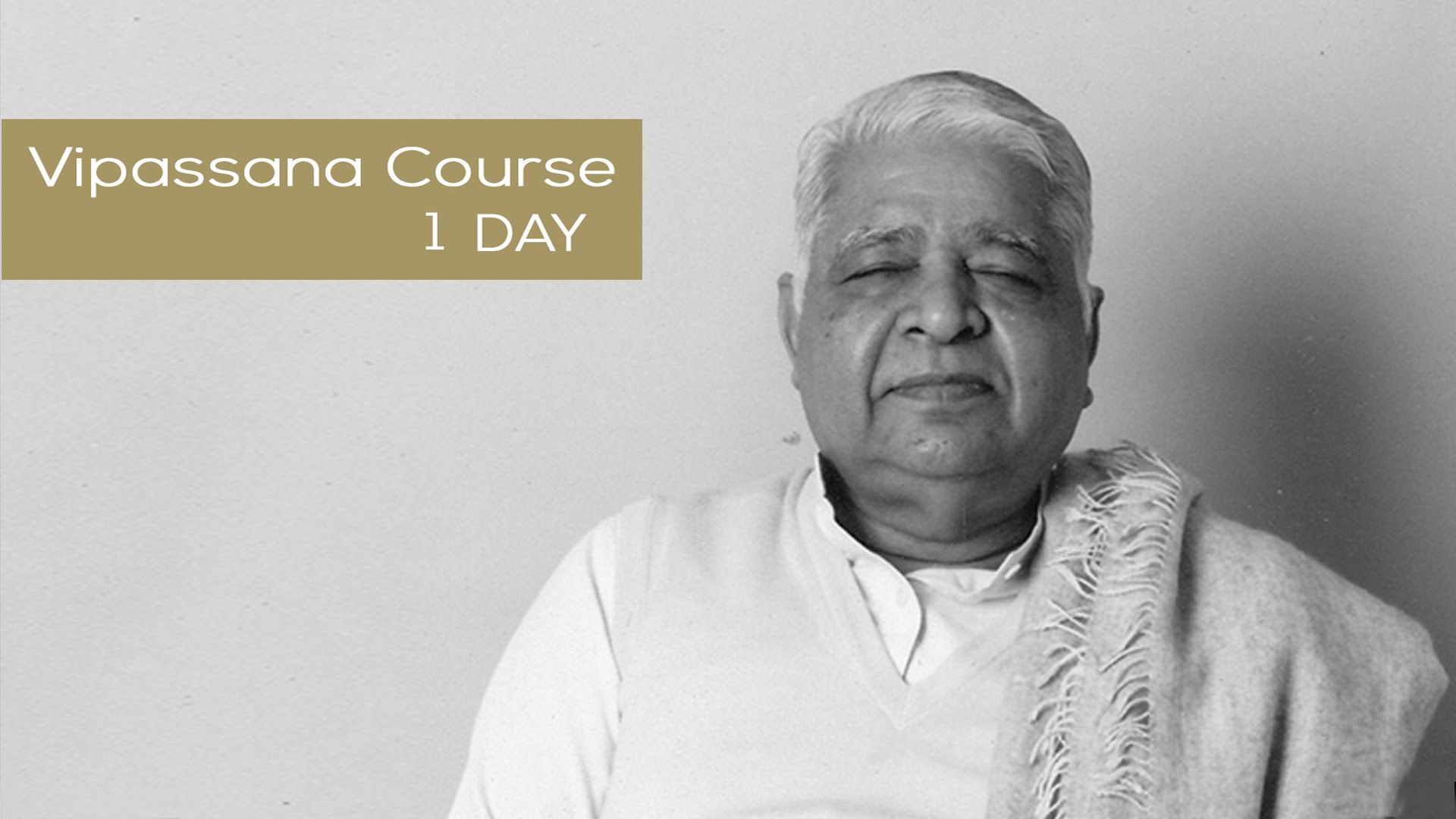Vipassana In Society
MAIN CONTENT
- Peace within oneself, for Peace in the World
- An Art of Living for transformation of an individual
- Vipassana – A Powerful Tool for Social Integration
- Vipassana as an Instrument of Reform
- Vipassana and Addiction
- Vipassana in Business: An Art of Corporate Management
- Vipassana in Government
- Anapana for Children: Planting the Seed of Dhamma
Peace within oneself, for Peace in the World
The ancient land of India gave more than just a message of peace and harmony to the world, it also showed a way to achieve it. If we want peace in human society, we cannot ignore the individuals. Mr. S. N. Goenka has often said, “If there is no peace in the mind of the individual, how can there be real peace in the world?” Rightly so, a person with an agitated mind, always full of anger, hatred, ill-will and animosity cannot give peace to the world. Enlightened people have therefore advised “Know thyself.” Which means not merely knowing at the intellectual level, or accepting at the emotional or devotional level. When you experience the truth about yourself, within yourself, at the experiential level, you are at peace.
To understand the truth within, the Buddha showed the Eight-fold Noble Path, with the three pillars of sila (morality), samadhi (mastery over the mind) and panna i.e. ‘pragya’ (purification of the mind, by developing insight).
Vipassana, the practical quintessence of the teaching of the Buddha, is not merely a theory or philosophy for any kind of intellectual entertainment and philosophical discussion, nor an emotional or devotional game. It is a down-to-earth, practical, rational, scientific, non-sectarian and result-oriented technique. By practicing Vipassana, one experiences the truth within, knowing how the mind and body keep influencing each other.
The practice of Vipassana helps lead one from impurity of mind to purity of mind. This transformation changes people in wonderful ways. It is no magic or miracle; this is a pure science of observing the interaction of mind and matter within. One examines how the mind keeps influencing the material body, and how the body influences the mind. Through patient observation, the law of nature becomes clear: whenever one generates mental negativity, one starts suffering; and whenever one is free from negativity, one enjoys peace and harmony.
When each person becomes peaceful and starts living a life of morality, the whole society will become an ideal society, happy and peaceful. After all, the society is made up of individuals.
An Art of Living for transformation of an individual
In the Buddha’s teaching, the human matters most; when we talk of humans, the mind matters most; and when we talk of the mind, purity matters most, so that it can generate pure love and compassion. Purity of mind can be achieved only when impurities are removed from the root level of the mind. It is this root of the mind which generates and multiplies impurities. And, if this habit pattern is not changed, the impure mind remains unchanged; the individual remains unchanged; and if the individual remains unchanged, the society and the world is not changed either. So the Buddha strikes at the root cause of misery, which is the foundation of the problem. To demolish this impure foundation, he rediscovered the powerful tool of Vipassana.
This ancient technique has now spread again around the world. Millions of people attend courses in India and the rest of the world. People from different communities, traditions and religions come to learn this technique, to obtain the same benefit. The balanced view of “know yourself, by yourself, for yourself”, as some students call it, helps one live peacefully and harmoniously with oneself and with others. The transformation in one’s attitude at the end of the course reduces stress, while increasing equanimity.
Other common benefits are growth in concentration and work efficiency, positive behaviour changes, effective decision-making, gentle speech and harmonious feelings towards others. Since the wisdom is gained through personal experience, one finds prejudice being replaced by compassion; jealousy at the success of others changing to joy; greed and arrogance getting transformed to generosity and humility. This mental change is the real conversion bought by Vipassana.
Vipassana also helps many to come out of their addictions to different intoxicants, complexes, depression, chronic health problems and psychosomatic issues. Increased positivity of mind delivers better health. By the practice of Vipassana, many students have been able to face life-altering situations, adversaries, illness and even death, with perfect equilibrium of mind.
The Buddha’s teaching has never been a Utopian dream of hollow idealism; it is a great unifying force in our strife-torn society. This has already been proven in the last 46 years – people and leaders belonging to different religions, castes, different communities, different classes of society and from different countries, cultures, join Vipassana courses in large numbers.
Be it economic or social status, a true practitioner of the Buddha’s teachings cannot and will not discriminate against any human being. People meditate together and eat together without having any difference of the so-called high or low ‘status’ or even the social tradition of untouchability. This is the teaching of the Buddha in practice. It is heartening to see this equality and integration, not merely at the level of principles, but at the actual level.
Like tributaries joining the river, the Buddha’s teachings are the practical conjunction (triveni) of sila (morality), samadhi (mastery over the mind) and panna i.e. ‘pragya’ (purification of the mind, by developing insight), all of which are universal and non-sectarian. That is why, at the time of the Buddha and even now, people from various sects, traditions, countries and cultures willingly practice Vipassana and enjoy the same benefits.
It is noteworthy, that to date, thousands of Christian priests and nuns, countless Jain munis and sadhvis, numerous Hindu and Buddhist monks and nuns have participated in Vipassana courses. Ordinary householders of these traditions number in hundreds of thousands and this number is multiplying every year.
The non-sectarian, scientific teachings of the Buddha spreading on a mass scale are a concrete, practical method to achieve social integrity. This is because, as one progressively experiences the teaching of the Enlightened One, it becomes impossible to believe in the differences of caste, community, sect, gender, social status and other factors of discrimination in the society.
Vipassana as an Instrument of Reform
The role of Vipassana in reform is threefold. First: It helps to remove the underlying defilements that manifest negative mental states in actions. Second: It helps the less fortunate to bear their suffering. Third: It strengthens those involved in helping such people, the social workers, doctors among others.
One example is in the area of prison reform. The courses in Tihar jail have resulted in increased discipline and in greater harmony between the inmates and staff, as representatives of both have learned the technique of self-introspection.
The practice of holding Vipassana courses in prisons was prevalent in Emperor Asoka’s time, and now, after millenia, the mind-purification technique of Vipassana has reached one of the most miserable sections of the society again. The first historic Vipassana course was held in 1975 in Central Jail, Jaipur, Rajasthan. Convicts, undertrials, hardened criminals who participated in that Vipassana course received the key to liberation from chains even more shackling than those around their limbs – the chain of the habit pattern of the mind to generate negativities like anger, hatred and ill-will.
Experiencing the reality within has helped many thousands suffering in prisons. Vipassana courses conducted in the prisons of India, Nepal, Canada, Colombia, Israel, Thailand, England and America have played an important role in improving the lives of prisoners. Meditation has reduced hostility and helplessness, leading to enhanced well-being and hope. The prisoners are not only improving themselves but are aspiring to become useful members of society after their term in prison. After their release, many prisoners are heading to serve Vipassana courses; some have gone to the families of victims to beg forgiveness, while some are even taking care of the family of people who were affected by their crimes.
Prisons in India are organizing Vipassana courses for their inmates, as a measure of reform. Prisons in other countries like the USA and the UK too have started introducing Vipassana. Many prison officials across the country realize that Vipassana meditation practice in society will help prevent crime. Prevention is no doubt better than cure.
Courses were conducted in India for leprosy patients bringing about an improvement in their attitude to life. They did not suffer from an inferiority complex as much as they did in the past. Vipassana brought smiles on their faces.
Vipassana courses in India and Nepal were beneficial for the visually impaired as well. People addicted to gambling, tobacco and other intoxicants, and even drugs have became free of their addictions. With the help of the Government in Switzerland and Australia, a lot of work has been done in this direction.
Vipassana and Addiction
Addiction represents one of the most serious problems of all countries and communities worldwide. It is universal in a sense that its object is not limited to drugs and substances. Anything can be an object of addiction – power, sexuality, human beings and mental objects.
Craving is the key issue in addiction. Addicts know (intellectually) very well that they are addicts. But they cannot change themselves, because freedom from cravings cannot be achieved by mere intellectual understanding. The cause of addiction is rooted in subconscious areas of mind and matter.
Although a recovery program needs a multi-modal approach (systemic therapy, biographic work, education, sports etc.), the craving itself must be understood and changed at the level where mind and matter interact. Otherwise, all efforts go waste because the craving is still present and further misery (e.g. substance abuse, obsessive gambling, etc.) is pre-programmed.
This points to the deepest understanding of craving. According to the Buddha, everything that arises in the mind flows together with sensations (Anguttara Nikaya 8, Mulaka Sutta). Sensations should be observed objectively to understand their real nature: Change (anicca), misery (dukkha), and substance-less (anatta). Thus, addiction is not addiction to a sensual object but always an addiction to the sensations that arise as a consequence of the object (e.g. alcohol, cigarettes). The real object of craving is craving itself and craving is accompanied by sensations of craving – the vicious circle starts. This view stands in line with neurobiological findings. The usage of drugs is a very unpleasant consequence of this process of continuous craving and reaction. As per the law of nature (Dhamma), if one does not react with craving and aversion towards these sensation by developing wisdom and equanimity, the sensations passes away and with it the mental part that contains the seed for further craving. Thus, the habit pattern of craving and reaction start to change.
With the help of this scientific technique, people addicted to gambling, tobacco and other intoxicants, and even drugs have become free of their addictions. With the help of the Government in Switzerland and Australia, a lot of work has been done in this direction. This ancient technique of Vipassana meditation together with Anapana is very important in case of crisis where it acts as an inhibitor to prevent addicts from a serious relapse.
Vipassana in Business: An Art of Corporate Management
Whether it is prisoners, people living on the streets, the have-nots of the world or the most affluent and wealthy sections of the society, everyone has gained the same beneficial results from Vipassana. Dhamma, the law of nature, is the same for all. Since all of us are prisoners of the negative habit patterns of our own minds, the practice of Vipassana helps us come out of our misery by eradicating the negativities from the root level of our minds.
Many business tycoons, corporate executives and top management have attended 10-day Vipassana courses and have found Vipassana as a useful tool in business management as well as in their personal growth.
In the words of Dr Roop Jyoti, a prominent businessman from Nepal, “Vipassana is an art of stress management. Vipassana is an art of people management. Vipassana is an art of conflict management. There may be more to the science of management, but Vipassana can become very nearly the art of total corporate management.”
Many business executives have reported an increase in their ability to work with superior performance and a significant decrease in greed, anger, arrogance, and prejudice besides lesser friction in dealing with staff members. With these positive changes and cordial interpersonal relations, the wealth of their enterprises has steadily increased.
Observing the benefits of Vipassana, numerous business and non-business organizations have begun providing paid leave to their employees to attend Vipassana meditation courses. Some have treated Vipassana as a training programme, some have included it in their Human Resources Development activity and yet others have simply considered it as an aspect of employee welfare. Vipassana has reduced instances of confrontation and situations where conflicts arise unnecessarily. After all, Vipassana makes a person live happily and happy individuals make a happy organization. Employees become grateful towards their employers for giving them the opportunity to learn Vipassana, and employers reap the rewards in the form of higher productivity and better morale.
Exclusive courses are being held for professionals at Centres around the world. It was Goenkaji’s desire to have centres devoted to conducting Vipassana Courses for professionals and executives in metropolitian cities, thereby encouraging them to taste the nectar of pure Dhamma. Following this vision, two such centers, Dhamma Pattana and Dhamma Vipula, were built in Mumbai, India. This would enable them to play a crucial role in the spread of Vipassana across all levels of society. This has been well received by high-ranking government officials and business executives all over the world.
Vipassana in Government
In the remote past, as far back as the third century BC, Ashoka, the great emperor of India, used Vipassana as an instrument of reforms in the governance of his vast empire. His actions in the administration and management of state reflect piety, love, magnanimity and high moral discipline. He organized a system of government-efficient, humane and responsive to public weal, unparalleled in human history.
In the recent past, Sayagyi U Ba Khin, the most outstanding teacher of Vipassana, introduced far reaching reforms in various government departments. He succeeded in eradicating corruption, instilled efficiency, accelerated the pace of decision-making and fostered harmony and better relationship. He has maintained that meditation can help in “creating a reservoir of calm and balanced energy to be used for the building of a welfare state and as bulwark against corruption in public life.”
Even today, many high level Government officials, senior civil servants and politicians have attended Vipassana courses. After experiencing the immense benefits of the technique themselves, these Government officials initiated the idea of using Vipassana as an instrument of reform, for the benefit of the society.
The Government of Rajasthan took a pioneering decision to introduce Vipassana as an instrument of reform in the government organisations. The first such course was conducted for jail inmates and staff. The course yielded wonderful results. The jail staff who participated in the course, developed compassion and greater awareness towards their duties and responsibilities.
After this initial success, numerous courses were held for police officers of all ranks, home departments and other Government departments. The course had a profound impact on the behavioral pattern of the participants. They got clear perceptions of their functions and roles, and developed greater awareness of their duty towards the society.
Senior officers in the Home department of the Government of Rajasthan who attended Vipassana courses were instrumental in initiating internal reforms in the department leading to the reduction of paper work, quicker decision making, clearance of pending work accumulated over years and better staff-officer relationship. Departments coming within the jurisdiction of Home Department were reorganised and their training system was streamlined resulting in greater efficiency, economy in functioning and inculcation of trust and harmony.
Many State Governments including Maharashtra, Madhya Pradesh and Rajasthan are giving fully paid leaves to their employees to attend Vipassana courses. The Government of Rajasthan has recently decided that police personnel of all ranks belonging to the State and Subordinate Services be introduced to Vipassana meditation courses, including personnel of various police stations in the city of Jaipur. The Government has also decided to have regular courses for trainees in the State Institute of Public Administration and Rajasthan Police Academy and other training institutes.
Today, Vipassana is practiced by officials at all levels of Indian Public administration, including senior administrators, judges, army and police officials, jail officers, forest officials, and auditors. Large studies conducted in 2001 and 2002 (Parihar/VRI 2004) have shown that 98 percent of the studies’s subjects have been benefited in their personal and professional lives from taking part in a Vipassana course. 95 percent furthermore reported that Vipassana has a direct role to play in improving public administration.
In the present times, government plays an all-pervasive role in society. The character and the quality of a government are shaped by the people who run the government and who control the government. They have to be trained to be humane, responsive and of high integrity. This cannot come about by imparting skills in management only. Attitudes have to be changed – an eternal challenge to the mankind. Vipassana can change attitudes.
Anapana for Children: Planting the Seed of Dhamma
Children today are growing up in a fractured and rapidly changing world. They need help to meet the challenges facing them and to develop their full potential. Anapana meditation helps them find a way to live peacefully and productively.
Anapana is the first step in the practice of Vipassana meditation. Anapana means observation of natural, normal respiration, as it comes in and as it goes out. It is an easy-to-learn, objective and scientific technique which helps develop concentration of the mind.
Since 1986, thousands of Anapana courses have been conducted exclusively for children around the world. These courses have yielded substantial benefits for millions of children who have attended them. They have experienced a positive change in their outlook, behaviour and attitude. Many have found their ability to concentrate has improved and their memory has strengthened. And above all, these children have acquired a tool that is of immense value to them for the rest of their lives.
Maharashtra Government, in association with Vipassana Research Institute, has initiated MITRA Upakram, to facilitate training of Anapana in schools. MITRA Upakram, which aims to inculcate Right Awareness, aspires to reach 2.5 crore school children and 1 Lac school teachers.
In India, Anapana courses have also been arranged for autistic children, homeless children, orphans, children with hearing and speech impairments, and children with physical and mental disabilities. In Pune, for example, a home for destitute children has offered Anapana courses for the last 10 years to its over 400 residents. Some children have gone on to learn Vipassana in longer courses. The local Vipassana center hosts frequent courses for children with hearing and speech impairments. These courses coupled with daily meditation have immensely improved their self-confidence.
In Myanmar, there have been courses for children with visual or hearing impairments, children affected by leprosy, and juvenile offenders in various institutions. In the aftermath of Cyclone Nargis in May 2008, old students organized a visit to southern Myanmar to offer physical assistance as well as Anapana courses; about 1,500 children participated within a few weeks.
These courses are helping children to grow up to be ideal human beings. This is the only aim of Anapana. After tremendous sucess and growth of Anapana courses for children, 7-days Vipassana courses are being conducted in India and Nepal for teenagers (age group – 15 (complete) to 19 years).
Source: https://www.vridhamma.org



![Videos [khóa Thiền Vipassana 2018] 07. Kinh Ananda (phần 2) | Thiền Sư U Jatila 3 7 9](https://satima.net/wp-content/uploads/2020/07/7-9-390x205.png)

![Videos [khóa Thiền Vipassana 2017] 10. Kinh Niết Bàn | Thiền Sư U Jatila 5 10 8](https://satima.net/wp-content/uploads/2020/07/10-8-390x205.png)

![Videos [khóa Thiền Vipassana 2017] 17. Kinh Loại Trừ Thân Kiến | Thiền Sư U Jatila 7 17 8](https://satima.net/wp-content/uploads/2020/07/17-8-390x205.png)